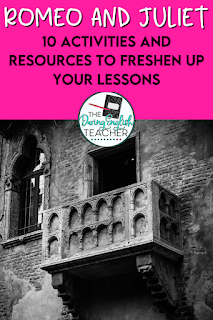Romeo and Juliet is one of those classic pieces of literature I think everyone has read. Even students who haven’t read the Shakespeare play have probably heard of the story or will relate to the plot as it has been retold in various films and literature. If you need some fresh ideas before you start this unit, read on.
Here are 10 activities for teaching Romeo and Juliet
1. Relatable Bell Ringers
If you’re going to focus on a Shakespeare play, you must go all in. Immersing students into a unit from start to finish is such a perfect way to help students understand a topic in-depth. Start off each class with these Shakespeare Bell Ringers. Each one includes a famous Shakespearean quote and a quick writing prompt. Students will explore various writing styles based on the quote.
2. Character Focus
Help your students identify and organize characters with these graphic organizers. This resource has two sets for almost every character in the play. Students will identify characters as round or flat, static or dynamic, and other basic qualities. This will also require them to provide textual evidence. The second organizer focuses on tracing emotions and motivations throughout the play. It’s a creative way for students to organize the play’s characters and is also a great resource for ESL students and struggling readers.
3. Get Interactive
I can remember interactive notebooks becoming all the rage. And while the paper notebooks are creative, a motivator for some students, and it’s generally pretty easy to put an interactive spin on old ideas already at hand. Having a digital version is just one more layer to add something unique to the interactive notebook. My digital notebook resource can work as its own unit and includes analysis activities covering characters, symbols, major events, writing tasks, and response questions. Digital notebooks are great for classrooms trying to limit paper use, use more technology, prepare students for tech demands, and for any classes that need to work with mobile options.
4. Engaging Writing Tasks
Help students understand and analyze the play by giving them unique writing assignments. Have students explore different writing styles, analyze universal themes, and study character development. My Writing Tasks resource does all this and more. Each act has its own unique writing assignment, and I’ve included brainstorming organizers for each. You’ll be able to use this with differentiated instruction, and there are several additional resources and organizers included.
5. Read “Cloze”ly
Prep passages for students to summarize to help them understand events from the play. This is an ideal activity for review, comprehension, or even assessment. Cloze reading is an ideal way to help students understand what is happening. Cut your prep time down by using this resource, with 6 passages ready to use AND written in modern-day English. Use as an individual assignment or collaborative activity.
6. Use Office Supplies
Increase student engagement with hands-on activities using sticky notes. You can use various colors to coordinate different aspects of study (literary elements, major events, character development, etc). It’s an easy and quick way for students to organize thoughts and notes, and the bits of information can be manipulated and moved around for different assignments. Students can gather relevant information for various essays, or can organize their sticky notes in a way that makes sense to them (by topic, or chronologically, as an example). Check out my Sticky Note Literary Analysis activity that includes 12 sticky note organizers.
7. Make Use of Bookmarks
There are many creative avenues when it comes to bookmarks. Have an activity where students pick a favorite quote, draw a scene, or draw what they know about the play prior to reading (they can use the back to draw after reading the play). Consider a foldable version like this one where you can jam-pack a variety of questions, vocabulary, literary analysis and more. These are foldable, interactive, fun, engaging – and it saves you time passing out one activity to be used throughout the play.
8. Plan an Escape
Escape rooms live up to the hype. Challenge your students with a fun and engaging review escape challenge. Have students work together in groups to complete collaboratively and spark authentic discussion. This escape room activity includes 40 timeline events to sort from the play correctly.
9. Don’t Forget Vocabulary
Vocabulary is an important aspect of understanding any work, but Shakespeare is on a whole other level. In addition to reading an older version of English in poetic form, students must grasp key vocabulary to understand the play more deeply. Engage your students with hands-on activities to learn vocabulary, whether that be through graphic organizers, visual dictionaries, or word puzzles. Check out my ready-to-print vocabulary packet that includes word lists, puzzles, organizers and quizzes for the entire play.
10. Practice Annotations
Start at the very beginning with an engaging activity for the prologue. This will allow students to explore the Shakespearean language and the set-up to the drama that is Romeo and Juliet’s tragedy. Using this resource, students will read and annotate the prologue, be introduced to Elizabethan English, and have context and background information before reading the play. Students then will rewrite the prologue in modern-day English following the same sonnet form. I love having students explore language, and this activity fits perfectly into the unit.
Bonus
If you’re starting fresh with activities to fill a unit, or you’re looking to refresh your tried-and-true activities, check out my 5-week unit plan for Romeo and Juliet here. It’s full of goodies including a pacing guide, pre-reading activities, bookmarks, vocabulary, passages, writing tasks, essays, review activities, and more.
Put a new spin on the classic tragedy by refreshing your activities and finding new ways to present to students. Just a few simple updates and changes can keep students engaged and help them relate to the material. I love seeing what others do in their classrooms, so please share your favorite ideas in the comments below.
Is Teaching Shakespeare’s Romeo and Juliet Still Revelant?
In an earlier blog post, I discuss if teaching Shakespeare is still relevant.



